Imaging Sci Dent.
2016 Sep;46(3):211-216. 10.5624/isd.2016.46.3.211.
Interactive learning in oral and maxillofacial radiology
- Affiliations
-
- 1Department of Diagnostic Sciences, Division of Oral and Maxillofacial Radiology, Tufts University School of Dental Medicine, Boston, MA, USA. Aruna.ramesh@tufts.edu
- KMID: 2408253
- DOI: http://doi.org/10.5624/isd.2016.46.3.211
Abstract
- PURPOSE
The use of electronic tools in teaching is growing rapidly in all fields, and there are many options to choose from. We present one such platform, Learning Catalyticsâ„¢ (LC) (Pearson, New York, NY, USA), which we utilized in our oral and maxillofacial radiology course for second-year dental students.
MATERIALS AND METHODS
The aim of our study was to assess the correlation between students' performance on course exams and self-assessment LC quizzes. The performance of 354 predoctoral dental students from 2 consecutive classes on the course exams and LC quizzes was assessed to identify correlations using the Spearman rank correlation test. The first class was given in-class LC quizzes that were graded for accuracy. The second class was given out-of-class quizzes that were treated as online self-assessment exercises. The grading in the self-assessment exercises was for participation only and not accuracy. All quizzes were scheduled 1-2 weeks before the course examinations.
RESULTS
A positive but weak correlation was found between the overall quiz scores and exam scores when the two classes were combined (P<0.0001). A positive but weak correlation was likewise found between students' performance on exams and on in-class LC quizzes (class of 2016) (P<0.0001) as well as on exams and online LC quizzes (class of 2017) (P<0.0001).
CONCLUSION
It is not just the introduction of technological tools that impacts learning, but also their use in enabling an interactive learning environment. The LC platform provides an excellent technological tool for enhancing learning by improving bidirectional communication in a learning environment.
MeSH Terms
Figure
Cited by 1 articles
-
The development of a learning management system for dental radiology education: A technical report
Hee-Jin Chang, Khanthaly Symkhampha, Kyung-Hoe Huh, Won-Jin Yi, Min-Suk Heo, Sam-Sun Lee, Soon-Chul Choi
Imaging Sci Dent. 2017;47(1):51-55. doi: 10.5624/isd.2017.47.1.51.
Reference
-
1. Petty J. Interactive, technology-enhanced self-regulated learning tools in healthcare education: a literature review. Nurse Educ Today. 2013; 33:53–59.
Article2. Ray K, Berger B. Challenges in healthcare education: a correlation study of outcomes using two learning techniques. J Nurses Staff Dev. 2010; 26:49–53.3. Knowles MS. The modern practice of adult education: from pedagogy to andragogy. New York: Cambridge Book Co;1989.4. Nichol D. E-assessment by design: using multiple-choice tests to good effect. J Further High Educ. 2007; 31:53–64.5. Schneiderman J, Corbridge S, Zerwic JJ. Demonstrating the effectiveness of an online, computer-based learning module for arterial blood gas analysis. Clin Nurse Spec. 2009; 23:151–155.
Article6. Dennison HA. Creating a computer-assisted learning module for the non-expert nephrology nurse. Nephrol Nurs J. 2011; 38:41–53.7. Nicol DJ, Macfarlane-Dick D. Formative assessment and self-regulated learning: a model and seven principles of good feedback practice. Stud High Educ. 2006; 31:199–218.
Article8. Sandahl SS. Collaborative testing as a learning strategy in nursing education. Nurs Educ Perspect. 2010; 31:142–147.9. JISC. Effective practice with e-assessment - an overview of technologies, policies and practice in further and higher education [Internet]. JISC;2007. cited 2016 Mar 15. Available from http://www.webarchive.org.uk/wayback/archive/20140615085433/http://www.jisc.ac.uk/media/documents/themes/elearning/effpraceassess.pdf.10. Bruff D. Teaching with classroom response systems: creating active learning environments. San Francisco: Jossey-Bass;2009.11. Nayak L, Erinjeri JP. Audience response systems in medical student education benefit learners and presenters. Acad Radiol. 2008; 15:383–389.
Article12. Hattie J, Timperley H. The power of feedback. Rev Educ Res. 2007; 77:81–112.
Article13. Kulhavy RW. Feedback in written instruction. Rev Educ Res. 1977; 47:211–232.
Article14. Tsai FS, Yuen C, Cheung NM. Interactive learning in preuniversity mathematics. In : IEEE International Conference on Teaching, Assessment, and Learning for Engineering (TALE) 2012 (TALE2012); 2012 Aug 20-23; Hong Kong. IEEE: 2012. p. T2D-8-13. .15. Richardson ML. Audience response techniques for 21st century radiology education. Acad Radiol. 2014; 21:834–841.
Article16. Bhargava P, Lackey AE, Dhand S, Moshiri M, Jambhekar K, Pandey T. Radiology education 2.0 - on the cusp of change: part 1. Tablet computers, online curriculums, remote meeting tools and audience response systems. Acad Radiol. 2013; 20:364–372.17. Schackow TE, Chavez M, Loya L, Friedman M. Audience response system: effect on learning in family medicine residents. Fam Med. 2004; 36:496–504.18. Latessa R, Mouw D. Use of an audience response system to augment interactive learning. Fam Med. 2005; 37:12–14.19. Meckfessel S, Stühmer C, Bormann KH, Kupka T, Behrends M, Matthies H, et al. Introduction of e-learning in dental radiology reveals significantly improved results in final examination. J Craniomaxillofac Surg. 2011; 39:40–48.
Article
- Full Text Links
- Actions
-
Cited
- CITED
-
- Close
- Share
- Similar articles
-
- Like & share: video-based learning through social media in oral & maxillofacial surgery
- Development of Interactive Multimedia Learning in Aging Education
- An overview of deep learning in the field of dentistry
- Education of Oral and Maxillofacial Radiology in South Korea
- Dose and risk in dental diagnostic imaging: with emphasis on dosimetry of CBCT


